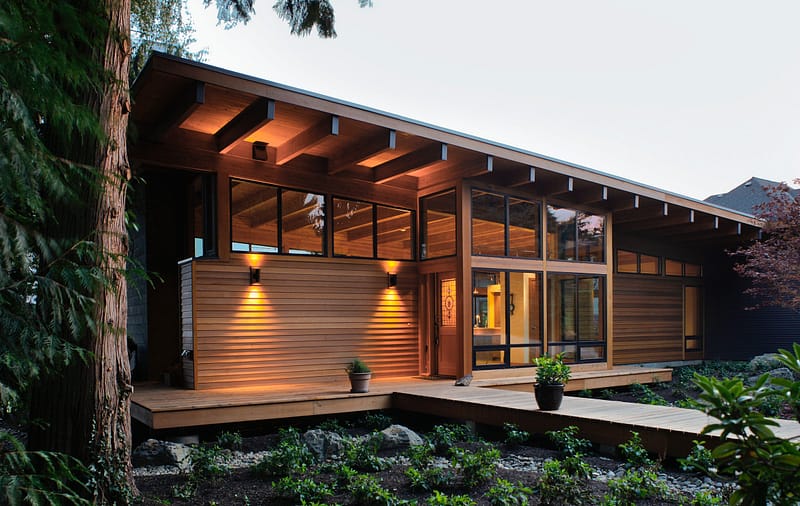Maybe you’ve been watching a neighbor build what appears to be a matching, miniature version of their home in their backyard and were wondering what the deal is. Or perhaps you’ve been planning ahead for your retirement years and are looking for an aging-in-place option, or a way to fold multiple generations within one home while retaining some semblance of privacy and autonomy. Accessory Dwelling Units, or ADUs, are popping up all over the place in Portland and Seattle as people are looking for flexible housing scenarios or ways to augment revenue streams with renters.
ADUs are known by many names such as mother-in-law apartments, granny flats, or backyard cottages. They can take several shapes, but the uniting characteristic is a self-contained dwelling within, attached to, or adjacent to a single-family home. ADUs are generally accessible through a separate entrance and contain their own living, sleeping, kitchen, and bathroom facilities. The four main flavors of ADUs include:
- Converting an existing living area
- Finishing an existing basement or attic
- Building a new freestanding structure
- Adding to an existing structure, such as a detached garage
In addition to personal benefits, ADUs increase housing options in cities with scorching real estate markets —such as Portland and Seattle—in ways that are sensitive to preserving a neighborhood’s cultural fabric and character.
This sounds great—I want to build an ADU! How do I get started?
1. Do your homework.
Finding the right type of ADU for your home takes careful planning and research. The best path forward depends on getting to know your site, home, and city zoning codes and requirements intimately. Things to consider are the City’s regulations on square footage limits, entrance location, and building setbacks, and, if an exterior modification in Portland, Community Design Standards or historic overlays. Also consider potential impact on utilities, water or sanitary/storm sewers, and septic tanks.
Do you have enough room in your backyard to accommodate setback requirements for a freestanding ADU? If you’re adding to an existing 1924 historic home, can your galvanized plumbing handle the additional volume an ADU will bring? Can your existing electric service handle the extra load diverted to the ADU, or will you need to perform infrastructure upgrades or install new electric service altogether? These are examples of the myriad questions you must investigate and answer to be sure you won’t run into a roadblock midstream. For answers to the most common questions about things like square footage and setbacks, see our ADU FAQs for Portland and for Seattle. To continue your research, be sure to review the detailed information in Portland’s ADU Program Guide or Seattle’s Attached ADU and Backyard Cottage Permitting Guides.
Also, be aware that both Portland and Seattle require a building permit, and Portland requires a round of design review. Portland also loves its arboreal population and implemented a new tree code that you must consult before getting too starry eyed about removing that giant old Douglas Fir to make room for your sweet new secondary digs.
2. Pencil out the cost.
With the vision of your ADU taking shape, the next step is crunching numbers. It is essential to understand the cost implications of your addition and this can be a tricky calculation, with the stock answer being “it depends.” Size, type of ADU, level of infrastructure upgrades required, and quality of finishes will impact the final price. There isn’t a pat answer for how much it costs to build an ADU, but we tried to give a general idea in our blog post, How Much Does it Cost to Build an ADU?
3. Get an architect and builder on board.
Hammer & Hand has built many ADUs and can help you walk the site and flag any concerns. If you already have an architect and/or a set of plans, great! If you’re still hunting around for the right designer, though, we can refer you to an architect skilled at ADU design once we dial in your project goals and style. The architect can help you navigate through the city permitting and design review process, while we can connect you to partners that have written bank loans for ADUs and appraisers that understand the ADU process.
I’m ready to get started! Where can I start researching?
- Portland Maps
Research your property, home history, zoning, and historic neighborhood designations. - City of Portland Bureau of Development Services ADU Information
The City’s central information hub for building an ADU in Portland. Process outlines, permit application, plan review process, and forms galore. - City of Portland ADU Program Guide
Portland’s bible of rules for developing a compliant ADU. - City of Portland Tree Code
Love thy poplar. - City of Seattle Attached ADU Permitting Guide
Seattle’s guide to navigating attached ADU permitting. - City of Seattle Backyard Cottage Permitting Guide
Seattle’s guide to navigating Backyard Cottage permitting.



